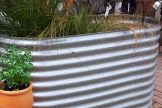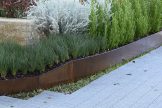
Given enough time, even the best quality ceramic and terracotta garden pots can be marred by mould, dirt stains, watermarks and efflorescence (the salty white bloom that you sometimes see on the outside of them). And those old garden pots that have been sitting by the front door or parked under the back veranda for years are sure to be showing their age. This is all well and good if you’re after that relaxed shabby-chic style or into the “distressed” look. But if you need to give them a good clean-up and want to return some of their former glory, help is at hand. If your pots have a salty white bloom on the outside, the best thing to do is brush it off with a dry scrubbing brush. Don’t use any water at this stage as it can cause the salts to be reabsorbed by the pot.
Once all the salty residue is removed you can attack it with some soapy water to remove all the dirt, grit and mould. For really stubborn stains you can try using a paving cleaner. When using the paving cleaner – don’t let the surface of the pot dry out while you’re scrubbing it, (you may need to rewet it). Once all the mould, dirt stains, watermarks and efflorescence have been removed, rinse the pot thoroughly, scrubbing as you go. To finish it off, scrub it a last time with a solution of kitchen detergent and then rinse it clean again.
Once the outside of the pot is clean, disinfecting the inside of the pot is highly recommended to help prevent the spread of diseases between your plants. To disinfect the pot, make up a mixture of one part bleach to nine parts water. If the pot is small enough, emerge the entire pot in the mixture for about 10 minutes, for larger pots, wash down thoroughly with the mixture. Once disinfected, wash down again with the kitchen detergent solution and then rinse off. Leave in the sun to dry off, the sun helps to further kill off any diseases through the effects of UV light and desiccation. Always use fresh potting mix when refilling the pot, the old potting mix can be added to a hot compost as the heat will kill off any of the nasty pathogens.
Sealing terracotta garden pots
Terracotta pots, especially those less than 30 cm in diameter can lose quite a bit of their water in summer as it is drawn out through the walls of the pot itself. If you are using these pots for plants that have high water requirements or don’t respond well to the wetting and drying cycle, sealing your terracotta pots is worthwhile.
You can either seal the inside or the outside of the pot. There are advantages and disadvantages to each option. If you’re looking to waterproof your terracotta garden pots and protect them against staining, water-based sealers (such as the Miteq Sealer 102) on the outside is the best product to use. These penetrating sealers sit just below the surface of pots and give them natural look and finish. Unlike surface sealers – which sit on the surface of the pots and give such them a high-gloss “wet” look – penetrating sealers also allow pots to “breathe,” which can help reduce the risks associated with overwatering and also help reduce the chance of root-rot developing.
Alternatively, if overwatering is unlikely to occur (using pot feet and drilling more holes in the base can help to stop this) or the pot has a finish that would not suit being sealed on the outside, sealing the inside of the pot is a good option. You can do this using a low toxicity paint or a pond sealer, simply paint the inside of the pot to the height just below where the potting mix finishes.
Always give the paint/sealer a couple days to fully dry before planting. When planting always use a premium quality tub and terracotta potting mix. These mixes are formulated to reduce the drying effects of terracotta pots and contain all the essentials required to encourage flourishing pot garden.





